2003+ Fuel pump tear down and failure analysis
#1
Having recently had the slow start fuel pump problem I was interested to understand what the failure actually was. I took SteveJacks advice and had a local indie do the repair (with warranty) and asked them to save the old pump for me to take a look at.
This has become especially interesting now that the problem has reoccurred in less than 400 miles on the new pump.
It's a reasonably compact, and in engineering terms at least, is a fairly simple and elegant design. Don't get me wrong, the price is outrageous and it could be made out of better materials, but the design itself isn't awful.
Now the pictures:
The can was in decent shape, but had some junk settled in the bottom. Not too terrible for 73k miles I suppose. The orange bit is a rubber stop attached to a little hinged door. This is the return loop that ensures the pump always has some fuel around it for cooling. There is a loop back directly from the pump output that is connected to the tube leading to the hinged valve. In that line is a small orifice to limit the amount of flow that comes directly back to the pump housing but always ensure that there is some.
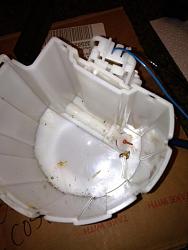
The pump itself didn't look too worse for wear. The filter screen is a little discolored but there were no tears or holes in it to let debris though.
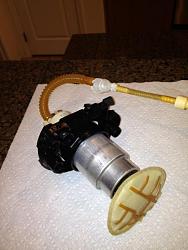
A close up of the seat for the infamous check valve. There are no broken tabs on this one and no signs of damage or wear on the valve seat. To the right is the 90deg fitting that connects the return to fill the pump basket.
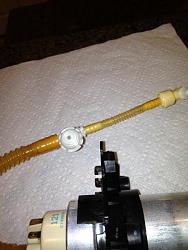
The other side of the check valve also looks to be in good shape. The rubber stopper isn't deformed, the o-ring seals are in good shape. The check valve itself is just a simple rubber cup attached to the end of a spring.
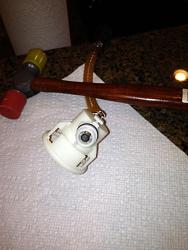
The spring and stop just pull out of the plastic housing. Looks like the spring from retractable pen and is just about as stiff. Not much to look at but is sure doesn't look like there is anything wrong with it.
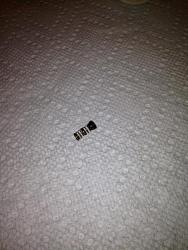
Lastly is the pressure regulator. Pretty low tech, mechanical device here. The fuel system pressure is regulated at the injector rail so I assume that this guy is in there to prevent the over pressure situation that the Rev ran into when putting a check valve outside of the tank. In this design, the check valve is BEFORE the regulator so it the pressure builds because of heat soak then it has a relief mechanism but will close off again once the pressure is back down to something near the operating pressure.
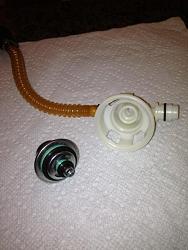
Not seeing any obvious problems I was scratching my head for a while. I plugged the end of the fitting where the check valve goes and blew in the output side of the fuel line. Not the best tasting thing, but this is for science!
Feels like a leak. Hmm... now the bubble test. Submerged the fitting end and tried again... the regulator is leaking!
I took the regulator out (and in the process broke the plastic tabs that hold it in) and tried to push against the spring. No way, it says. That thing was stuck.
Some close up inspection through the top side hole, it looks like there are some debris bits or other barnacles around the spring coils. Hard to see in there but it didn't look clean.
It wasn't going to move by hand but with a center punch and a little tap from the hammer it now moves more or less freely. Enough that it seals anyway.
I have to wonder if that isn't the reason for the rash of failures. If these are prone to corrosion the replacements are essentially sitting open to the environment on a shelf in a warehouse. They get a little sticky and then don't completely close.
When that happens,the fuel drains back and voila, slow start all over again. It would also result in a loss of fuel pressure since the regulator would essentially serve as a permanent bypass.
It has a P/N of: 107775 1959 NV
A quick google didn't come up with anything, but this can't be anything too special. Have to wonder if there is a suitable replacement part out there somewhere.
This has become especially interesting now that the problem has reoccurred in less than 400 miles on the new pump.
It's a reasonably compact, and in engineering terms at least, is a fairly simple and elegant design. Don't get me wrong, the price is outrageous and it could be made out of better materials, but the design itself isn't awful.
Now the pictures:
The can was in decent shape, but had some junk settled in the bottom. Not too terrible for 73k miles I suppose. The orange bit is a rubber stop attached to a little hinged door. This is the return loop that ensures the pump always has some fuel around it for cooling. There is a loop back directly from the pump output that is connected to the tube leading to the hinged valve. In that line is a small orifice to limit the amount of flow that comes directly back to the pump housing but always ensure that there is some.

The pump itself didn't look too worse for wear. The filter screen is a little discolored but there were no tears or holes in it to let debris though.

A close up of the seat for the infamous check valve. There are no broken tabs on this one and no signs of damage or wear on the valve seat. To the right is the 90deg fitting that connects the return to fill the pump basket.

The other side of the check valve also looks to be in good shape. The rubber stopper isn't deformed, the o-ring seals are in good shape. The check valve itself is just a simple rubber cup attached to the end of a spring.

The spring and stop just pull out of the plastic housing. Looks like the spring from retractable pen and is just about as stiff. Not much to look at but is sure doesn't look like there is anything wrong with it.

Lastly is the pressure regulator. Pretty low tech, mechanical device here. The fuel system pressure is regulated at the injector rail so I assume that this guy is in there to prevent the over pressure situation that the Rev ran into when putting a check valve outside of the tank. In this design, the check valve is BEFORE the regulator so it the pressure builds because of heat soak then it has a relief mechanism but will close off again once the pressure is back down to something near the operating pressure.

Not seeing any obvious problems I was scratching my head for a while. I plugged the end of the fitting where the check valve goes and blew in the output side of the fuel line. Not the best tasting thing, but this is for science!
Feels like a leak. Hmm... now the bubble test. Submerged the fitting end and tried again... the regulator is leaking!
I took the regulator out (and in the process broke the plastic tabs that hold it in) and tried to push against the spring. No way, it says. That thing was stuck.
Some close up inspection through the top side hole, it looks like there are some debris bits or other barnacles around the spring coils. Hard to see in there but it didn't look clean.
It wasn't going to move by hand but with a center punch and a little tap from the hammer it now moves more or less freely. Enough that it seals anyway.
I have to wonder if that isn't the reason for the rash of failures. If these are prone to corrosion the replacements are essentially sitting open to the environment on a shelf in a warehouse. They get a little sticky and then don't completely close.
When that happens,the fuel drains back and voila, slow start all over again. It would also result in a loss of fuel pressure since the regulator would essentially serve as a permanent bypass.
It has a P/N of: 107775 1959 NV
A quick google didn't come up with anything, but this can't be anything too special. Have to wonder if there is a suitable replacement part out there somewhere.
The following 3 users liked this post by ccfulton:
#2
I haven't followed all the discussions about fuel pump problems, have the replacements all failed fairly soon after installation or have some been longer? Also, does it make a difference how long the car is left - does it get easier to start after a few days for example?
Really interested in your diagnosis for the pump however. Just one more question, is there a fault code which indicates the starting problem you had with the pump?
Really interested in your diagnosis for the pump however. Just one more question, is there a fault code which indicates the starting problem you had with the pump?
#3
Normal would be described as: turn key to start, about 1sec of spinning, engine fires, revs to about 1100rpm and then settles down to a smooth idle.
The hard or slow start problem: turn key to start, 3-5sec of spinning, engine stumbles and sputters, might die or cough its way to normal idle speed but does not rev to 1100 like normal.
From the outside it looks and feels like fuel starvation but once the car is running, there aren't any further issues (at least at first).
No codes at the beginning, just a slow start. The problem may get progressively worse to the point where there are running problems like stumbling or misfires at more higher throttle positions. If you get to the point of having low fuel pressure when trying to drive, you will likely see some codes but I never got that far along, figuring it was just a matter of time, so went ahead with the pump replacement.
That I have read, there are two confirmed failure modes. One is the check valve as was the case with the Rev, where the plastic tabs holding the valve together had broken. The other is what I saw, where the check valve seemed to be in good working order but the mechanical regulator was stuck slightly open and bypassing fuel.
Essentially what happens is that when one end of the fuel line is open like that, then the fuel can drain back to the tank and there is no fuel available to start until it's been pumped from the tank to the fuel rail again.
The drain back happens in a few minutes so whether the car sits for 15 minutes or a day or a week doesn't seem to matter much.
As for the repeat failures, as I understand from Steve's experience, it was a rash of quick failures. Mine was similar, less than 400 miles driven.
I have a hard time imagining that the check valve is the problem with these barring some kind of gross physical damage to the mechanism that holds it in place as it is a very simple design. The regulator failing seems more plausible (to me) for this early mortality problem.
The hard or slow start problem: turn key to start, 3-5sec of spinning, engine stumbles and sputters, might die or cough its way to normal idle speed but does not rev to 1100 like normal.
From the outside it looks and feels like fuel starvation but once the car is running, there aren't any further issues (at least at first).
No codes at the beginning, just a slow start. The problem may get progressively worse to the point where there are running problems like stumbling or misfires at more higher throttle positions. If you get to the point of having low fuel pressure when trying to drive, you will likely see some codes but I never got that far along, figuring it was just a matter of time, so went ahead with the pump replacement.
That I have read, there are two confirmed failure modes. One is the check valve as was the case with the Rev, where the plastic tabs holding the valve together had broken. The other is what I saw, where the check valve seemed to be in good working order but the mechanical regulator was stuck slightly open and bypassing fuel.
Essentially what happens is that when one end of the fuel line is open like that, then the fuel can drain back to the tank and there is no fuel available to start until it's been pumped from the tank to the fuel rail again.
The drain back happens in a few minutes so whether the car sits for 15 minutes or a day or a week doesn't seem to matter much.
As for the repeat failures, as I understand from Steve's experience, it was a rash of quick failures. Mine was similar, less than 400 miles driven.
I have a hard time imagining that the check valve is the problem with these barring some kind of gross physical damage to the mechanism that holds it in place as it is a very simple design. The regulator failing seems more plausible (to me) for this early mortality problem.
The following users liked this post:
Bob OB (06-15-2014)
#4
Thanks for the reply. It doesn't sound like the same issue I have because mine actually gets better if I leave if for a few days, then taking a while before it gets difficult to start again. I have a fault code for the catalytic converter (I've discussed it in another post I started) but sometimes wonder if it could be something else, certainly feeling a bit like fuel starvation in a way.
My pump is just over 6 months and 10k miles old, so a different failure to the ones you are saying if it is that anyway.
My pump is just over 6 months and 10k miles old, so a different failure to the ones you are saying if it is that anyway.
#5
If it's hard starting after sitting a brief period but better after a longer time you might try putting a gauge on the fuel rail and checking the pressure.
If that mechanical regulator fails the other way and is stuck closed, you could get a period where the pressure goes too HIGH because of the heat of the engine causing the fuel in the rails and lines to expand.
The Rev described something like that when he put a check valve on the outside of the tank (downstream of the pump module).
If that mechanical regulator fails the other way and is stuck closed, you could get a period where the pressure goes too HIGH because of the heat of the engine causing the fuel in the rails and lines to expand.
The Rev described something like that when he put a check valve on the outside of the tank (downstream of the pump module).
The following users liked this post:
andyps (09-04-2012)
#6
#7
Finally an update on the fuel pump saga:
The shop I go to diagnosed it as a failed pump. Same mode as before, where the pressure bleeds down almost immediately when the pump shuts off.
Turns out this one had failed in a completely new way. One of the clips that holds the pump in place had broken and the pump was sort of rattling around in there pulling on all of the tubes and wires.
They sourced a replacement and when it arrived it was described to have "looked as though it were caught in the middle of a rugby match". This didn't meet with their standards so they declined to install it.
I feel I'm rather fortunate to have an indie that has a similar level of OCD as I do.
A few days later another new pump arrived and was installed. Time will tell whether this one suffers a similar fate. They warrant things for 1yr or 12k miles so the wallet gets some peace of mind if not my blood pressure.
P.S.
I forgot to mention that I had installed RealGauge when I dropped the car off. That caused a bit of confusion as they were road testing the car and earned me an interrogation when I went to pick it up.
The shop I go to diagnosed it as a failed pump. Same mode as before, where the pressure bleeds down almost immediately when the pump shuts off.
Turns out this one had failed in a completely new way. One of the clips that holds the pump in place had broken and the pump was sort of rattling around in there pulling on all of the tubes and wires.
They sourced a replacement and when it arrived it was described to have "looked as though it were caught in the middle of a rugby match". This didn't meet with their standards so they declined to install it.
I feel I'm rather fortunate to have an indie that has a similar level of OCD as I do.
A few days later another new pump arrived and was installed. Time will tell whether this one suffers a similar fate. They warrant things for 1yr or 12k miles so the wallet gets some peace of mind if not my blood pressure.
P.S.
I forgot to mention that I had installed RealGauge when I dropped the car off. That caused a bit of confusion as they were road testing the car and earned me an interrogation when I went to pick it up.

Trending Topics
#8
I was wondering which side of the regulator you hit ... I have the same problem and have meticulously taken this thing apart over three days searching for the problem ....and wallah ! after reading your post .. noticed my regulator is froze up also ...after playing whack a mole with the tabs finnaly managed to get this thing out ... afraid to bang on it too hard ...as with all this other plastic tab stuff that feels like it will break at any moment ... does anyone know of a replacement ? going to try and soak it in parts cleaner wondering if it will damage the diaphram in any way .. if it dont work I will resort to the "Fuel pump Hammer" I have a universal one that works on most items especially electronic ones ..lol
#9
The tabs on mine broke, but since I already had a new pump it was less a concern.
I pushed it gently from both sides and it wouldn't budge. To finally break it loose, I used a punch that would fit though the hole on the o-ring side and pushed against the spring force.
I set it on the bench and gave it a couple of taps with a small plastic tipped hammer and after that it would move pretty freely when pressing by hand.
I wasn't able to cross reference any of the numbers on the part itself and couldn't come up with a direct replacement. It is functionally very similar to a mechanical fuel pressure regulator except that the top is open instead of having a fitting to connect a manifold pressure reference.
I pushed it gently from both sides and it wouldn't budge. To finally break it loose, I used a punch that would fit though the hole on the o-ring side and pushed against the spring force.
I set it on the bench and gave it a couple of taps with a small plastic tipped hammer and after that it would move pretty freely when pressing by hand.
I wasn't able to cross reference any of the numbers on the part itself and couldn't come up with a direct replacement. It is functionally very similar to a mechanical fuel pressure regulator except that the top is open instead of having a fitting to connect a manifold pressure reference.
#10
#11
soaked it in mineral spirits overnight and it has freed right up and can be pushed easily with the punch ....no need for hammer ...maybe next time lol... Insight ...my car is the classic "garage queen" and judging from the height of the valve when installed in tank you need at least 2/3 tank of gas to keep the valve submerged in fluid where corrosion can not take place .... I believe that is where the problem originates!!!
#12
I can't really say what would help.
I didn't cut the regulator apart to see what kind of diaphragm is actually in there so I'm not sure whether corrosion or lubrication or what is really the problem. I know that it was stuck, but not why.
Intuition tells me that it was probably corrosion and that there won't be much we can do to prevent that kind of failure as any additive is going to be diluted by the fuel that's in the tank.
What might help would be to keep the pump assembly completely submerged so that it isn't exposed to air and keep enough fuel in the talk to prevent condensation. Ethanol becomes slightly acidic when mixed with water and may contribute to the problems.
Keep in mind, all of this is a logical extrapolation and I have no actual data to support any of it.
I didn't cut the regulator apart to see what kind of diaphragm is actually in there so I'm not sure whether corrosion or lubrication or what is really the problem. I know that it was stuck, but not why.
Intuition tells me that it was probably corrosion and that there won't be much we can do to prevent that kind of failure as any additive is going to be diluted by the fuel that's in the tank.
What might help would be to keep the pump assembly completely submerged so that it isn't exposed to air and keep enough fuel in the talk to prevent condensation. Ethanol becomes slightly acidic when mixed with water and may contribute to the problems.
Keep in mind, all of this is a logical extrapolation and I have no actual data to support any of it.
The following users liked this post:
Stumpy (03-10-2013)
#13
Charlie.....Generally I do not use additives in any of my vehicles ... but after thinking on this a while.... the small hole in the top of the regulator would allow fuel to be stored ....when parked for a length of time without adequate fuel height the fuel inside would evaporate lleaving behind the "gummy additives" that are present in modern fuels ...after years of this cycle repeating it seems the evaporated additives create a sticky glue ring that would cause the problem even trap particles not allowing the valve to close properly and eventually ceasing altogether which seems the case... allowing for pressure to be released ... so I believe the answer to your question would be YES ... what additives should be used however is good question (not sure how a fuel stabilizer would affect injector performance) ...In the mean time from now on I will store the car with a full tank of gas!!
#14
Do some searching on recreational boating sites for storage additives. The consequences of ethanol are well understood in that area.
also:
http://ieeexplore.ieee.org/xpl/freea...number=5557621
Ethanol and Storage Tank Corrosion | Blog | Energy Tomorrow
Surface Corrosion in Ethanol Fuel Pumps
Catastrophic failures of fuel pumps used to transport ethanol have occurred in various facilities. Failures occurred in as little as 50 hours on pumps with a 2000 hour life expectancy. Post-failure inspection of the pumps showed corrosive pitting of the metal in the areas of sliding contact. Several potential causes, including cavitation, thermal expansion of pump parts, and fuel contaminants such as acetic acid were ruled out. Fuel samples from facilities with high pump failure rates passed all D 4806 specification tests for fuel-grade ethanol, including titratable acid by D 1613. However, pH readings as low as 2.0 indicated potentially corrosive fuels. Controlled tests on pumps and corrosion tests showed that pump failures correlated with fuel pH. Corrosive fuels were found to contain ethyl sulfate, which correlated with fuel pH. It appears that ethyl sulfate originates from
sulfur dioxide, which is used as an antioxidant and antiseptic in the production of ethanol.
Ethanol - Wikipedia, the free encyclopedia
Ethanol a suspect in corrosion from Ultra Low Sulfur Diesel | Equipment World | Construction Equipment, News and Information | Heavy Construction Equipment
also:
http://ieeexplore.ieee.org/xpl/freea...number=5557621
Ethanol and Storage Tank Corrosion | Blog | Energy Tomorrow
Surface Corrosion in Ethanol Fuel Pumps
Catastrophic failures of fuel pumps used to transport ethanol have occurred in various facilities. Failures occurred in as little as 50 hours on pumps with a 2000 hour life expectancy. Post-failure inspection of the pumps showed corrosive pitting of the metal in the areas of sliding contact. Several potential causes, including cavitation, thermal expansion of pump parts, and fuel contaminants such as acetic acid were ruled out. Fuel samples from facilities with high pump failure rates passed all D 4806 specification tests for fuel-grade ethanol, including titratable acid by D 1613. However, pH readings as low as 2.0 indicated potentially corrosive fuels. Controlled tests on pumps and corrosion tests showed that pump failures correlated with fuel pH. Corrosive fuels were found to contain ethyl sulfate, which correlated with fuel pH. It appears that ethyl sulfate originates from
sulfur dioxide, which is used as an antioxidant and antiseptic in the production of ethanol.
Ethanol - Wikipedia, the free encyclopedia
Ethanol a suspect in corrosion from Ultra Low Sulfur Diesel | Equipment World | Construction Equipment, News and Information | Heavy Construction Equipment
The following users liked this post:
Bob OB (06-15-2014)
#15
It is great meeting you all and really love the feedback ..I am glad I joined the forum and hope to be a contributing addition for years to come ...wish I had joined a long time ago ...bear with me as I am not very computer savy and did not mean to post in the wrong category... I have read the intro thread and will do my best to not do it again!! As with anything time and practice will make perfect! ... I will repost after assembly and see if the problem has been cured as the only part that I had serviced is the valve ..it should be a good indicator and may help others in the future to pinpoint their issue quickly ...As you said charlie its all somewhat speculative ... so to my question ...does anyone know if there should be a tube connected to the 90 degree barbed fitting that is part of the check valve housing? when i blow through it it seems to allow the air to pass down the tube returning to the bottom of the pump ..it seems there should be a 1/4 " tube attached going to the vent system but cannot find it anywhere in the tank?
Last edited by bzviguy; 03-08-2013 at 01:54 PM.
#16
so to my question ...does anyone know if there should be a tube connected to the 90 degree barbed fitting that is part of the check valve housing? when i blow through it it seems to allow the air to pass down the tube returning to the bottom of the pump ..it seems there should be a 1/4 " tube attached going to the vent system but cannot find it anywhere in the tank?
I still have the pump I took apart, so when I get home I can have a look at it and maybe discern what you are referring to.
The following users liked this post:
bzviguy (03-08-2013)
#17
Hey everyone ...well its been three days and starts right up everytime ...10 minutes twenty minutes next day ...no problems....Total cost $3 for an old style feeler gauge to get the clips apart a few q-tips and 4 oz of mineral spirits ..... Thanx and that info on the fuels is very interesting!! Think I ll do some more research on it!
Last edited by bzviguy; 03-12-2013 at 09:37 PM.
#18
#19
I cut the bottom out of empty soda bottle filled with mineral spirits and submerged the valve ...used q tips to get inside small holes and cleaned the best i could ... the q tips all turned a dark brown /black color ... also used small dremel tool to buff copper electrical fittings on pump itself to insure good connection they had brown / black film also ...
